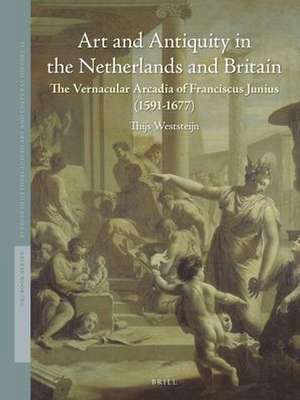Art and Antiquity in the Netherlands and Britain: The Vernacular Arcadia of Franciscus Junius (1591-1677): Studies in Netherlandish Art and Cultural History, cartea 12
Autor Thijs Weststeijnen Limba Engleză Hardback – 12 feb 2015
Preț: 739.55 lei
Preț vechi: 901.89 lei
-18% Nou
Puncte Express: 1109
Preț estimativ în valută:
141.56€ • 153.81$ • 118.99£
141.56€ • 153.81$ • 118.99£
Carte indisponibilă temporar
Doresc să fiu notificat când acest titlu va fi disponibil:
Se trimite...
Preluare comenzi: 021 569.72.76
Specificații
ISBN-13: 9789004283619
ISBN-10: 9004283617
Pagini: 452
Dimensiuni: 170 x 245 x 33 mm
Greutate: 1.36 kg
Editura: Brill
Colecția Brill
Seria Studies in Netherlandish Art and Cultural History
ISBN-10: 9004283617
Pagini: 452
Dimensiuni: 170 x 245 x 33 mm
Greutate: 1.36 kg
Editura: Brill
Colecția Brill
Seria Studies in Netherlandish Art and Cultural History
Cuprins
Contents
Acknowledgments ix
List of Illustrations x
List of Abbreviations xxiii
Introduction: Franciscus Junius’ Vernacular Arcadia 1
“An Extremely Learned and Famous Man” 9
Painting and Philology in the Netherlands 13
Artistic Terms in Latin and in the Vernacular 19
Junius in the European “Republic of Painting” 23
1 “Transform this Age into a Golden One”: Junius and the Arundel Collection 31
Dutch Art in England: The Arundel Circle 41
Antiquarianism in Britain and the Netherlands 47
The Genesis of The Painting of the Ancients 66
Arundel’s Paper Museum 73
The Gentleman’s Exercise: Civil Conversations about Art 87
2 More than a Paraphrase: The Painting of the Ancients in Latin, English, and Dutch 103
“More than Paraphrastic License” 116
Differences in Terminology 124
Junius, Van Hoogstraten, De Lairesse, and Rembrandt 128
“Polishing” and “Demarcating” the Vernacular 140
3 Dutch and English Antiquity: The Germanic Origins of Art 151
The Germanic Languages as Languages of Art 153
Germanic Iconography 155
Germanic Style 175
Rembrandt’s Conspiracy of Claudius Civilis 181
Aftermath: The Saxon Gods at Stowe 188
4 Actualizing the Ancients: Junius, Vossius, Lampsonius 195
The Neo-Latin Tradition of Art Theory 199
The Four Popular Arts 203
The Concept of Graphein 206
Painting and Rhetoric 208
Actualizing the Ancients 211
The “Father of Painting in the Netherlands”: Lambert Lombard 227
Classical Scholarship and the Painter’s Studio: A Vernacular Symbiosis 235
5 The Painter’s Right Hand: Teghenwoordigheydt and the Presence of Painting 245
The Reception of Junius’ Ideas among Artists 245
Painting and Ekphrasis 248
Presence, or Teghenwoordigheydt 258
“As if the artist were present” 260
The Beholder’s Presence 268
The Artistic Experience: A Mental Activity for Both Artist and Viewer 277
Conclusion: From Mimesis to Imagination 289
Imagination and Lifelikeness 290
“A Hidden Room”: Art as a Shelter from Conflict 300
Coda: The Presence of the Past as an Aesthetic Ideal 311
Appendices
Gerardus Vossius, The Art of Painting (1650) 315
Table 1: Contents of Junius’ The Painting of the Ancients 327
Table 2: The Reception of Junius’ Treatise in the Seventeenth and Eighteenth Centuries 329
Table 3: Major Differences between the English and Dutch Editions 358
Table 4: Terminology in the Dutch Edition 369
Notes 381
Bibliography 422
Index of Names 443
Acknowledgments ix
List of Illustrations x
List of Abbreviations xxiii
Introduction: Franciscus Junius’ Vernacular Arcadia 1
“An Extremely Learned and Famous Man” 9
Painting and Philology in the Netherlands 13
Artistic Terms in Latin and in the Vernacular 19
Junius in the European “Republic of Painting” 23
1 “Transform this Age into a Golden One”: Junius and the Arundel Collection 31
Dutch Art in England: The Arundel Circle 41
Antiquarianism in Britain and the Netherlands 47
The Genesis of The Painting of the Ancients 66
Arundel’s Paper Museum 73
The Gentleman’s Exercise: Civil Conversations about Art 87
2 More than a Paraphrase: The Painting of the Ancients in Latin, English, and Dutch 103
“More than Paraphrastic License” 116
Differences in Terminology 124
Junius, Van Hoogstraten, De Lairesse, and Rembrandt 128
“Polishing” and “Demarcating” the Vernacular 140
3 Dutch and English Antiquity: The Germanic Origins of Art 151
The Germanic Languages as Languages of Art 153
Germanic Iconography 155
Germanic Style 175
Rembrandt’s Conspiracy of Claudius Civilis 181
Aftermath: The Saxon Gods at Stowe 188
4 Actualizing the Ancients: Junius, Vossius, Lampsonius 195
The Neo-Latin Tradition of Art Theory 199
The Four Popular Arts 203
The Concept of Graphein 206
Painting and Rhetoric 208
Actualizing the Ancients 211
The “Father of Painting in the Netherlands”: Lambert Lombard 227
Classical Scholarship and the Painter’s Studio: A Vernacular Symbiosis 235
5 The Painter’s Right Hand: Teghenwoordigheydt and the Presence of Painting 245
The Reception of Junius’ Ideas among Artists 245
Painting and Ekphrasis 248
Presence, or Teghenwoordigheydt 258
“As if the artist were present” 260
The Beholder’s Presence 268
The Artistic Experience: A Mental Activity for Both Artist and Viewer 277
Conclusion: From Mimesis to Imagination 289
Imagination and Lifelikeness 290
“A Hidden Room”: Art as a Shelter from Conflict 300
Coda: The Presence of the Past as an Aesthetic Ideal 311
Appendices
Gerardus Vossius, The Art of Painting (1650) 315
Table 1: Contents of Junius’ The Painting of the Ancients 327
Table 2: The Reception of Junius’ Treatise in the Seventeenth and Eighteenth Centuries 329
Table 3: Major Differences between the English and Dutch Editions 358
Table 4: Terminology in the Dutch Edition 369
Notes 381
Bibliography 422
Index of Names 443
Notă biografică
Thijs Weststeijn is Associate Professor of Art History at the University of Amsterdam. He has published widely on seventeenth-century art and theory, including The Universal Art of Samuel van Hoogstraten (2013) and The Visible World (2008).
Recenzii
"Weststeijn’s book is a major contribution to the scholarship on seventeenth-century art theory and practice and is an exemplar for future studies on the subject."
John R. Decker, Georgia State University
John R. Decker, Georgia State University







